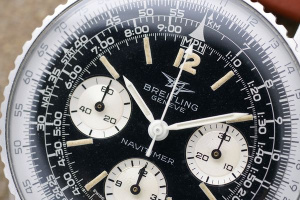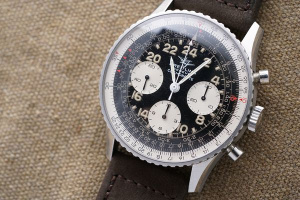Breitling Navitimer 806

Brief History
The Breitling Navitimer is an evolution of the 1942 Breitling Chronomat, with its typical slide rule bezel. Breitling decided to improve this highly practical bezel and in 1952, the ‘Navi’ was born. This slide rule bezel was used to calculate complicated operations without any other tool. The 1942 Chronomat came with an out-sourced movement, the Venus 176. It was used by the United States Air Force.
1952: the very first Navitimer wore the “Aircraft Owners and Pilots Association” (AOPA) emblem on its dial (the typical double-wing logo) and by 1960, a real cooperation with the AOPA began. The “Navitimer” name is the contraction of “navigation” and “timer”. The first edition to be sold was the reference 806, powered by a manual chronograph movement with column wheel mechanism, the Venus 178.
1954: the 806 was equipped with a Valjoux 72 (the same movement as the vintage Rolex Daytona) and thus, are among the most collectible.
Willy Breitling, helped by the Swiss advertiser Georges Caspari, developed a campaign that targeted groups of pilots and that created a huge demand for navigation chronographs. Furthermore, Breitling continued to be the official supplier of board instruments for all the major aircraft companies – as for example the 1957 Boeing 707, equipped with Breitling dashboard instruments.
At the end of the 1960s, Breitling chose to change the Venus 178 with a Valjoux 7740, a manually wound movement, cam-operated with a date feature. An automatic chronograph movement would follow in 1969.
The man behind the development of this new calibre was Gérald Dubois, who was working for Dépraz & Cie (now famous with the name Dubois Dépraz). Using a base calibre from Buren (a thin automatic movement with a micro-rotor), Dubois worked together with Jack Heuer and Willy Breitling to develop this brand new idea of an automatic chronograph. And that cooperation led to the creation of a modular chronograph mechanism, added on the top of the Buren calibre (for that reason, the integrated micro-rotor is invisible). The legendary Calibre 11 was born. One very unique feature of this movement is its left-positioned crown (the pushers are, as usual, located on the right side of the case). The introduction of this movement changed massively the face of the Navitimer that moved from a tri-compax layout to a bi-compax with date at 6 o’clock configuration. See also the Heuer Monaco for use of this movement.
Pre806 AOPA model

The first Navitimers ever produced were intended for the sole use by members of the Aircraft and Pilot Association (commonly referred to as the AOPA). They do not bear any reference numbers on the caseback, and were produced for only one year, from late 1954 until 1955. These are incredibly rare and highly prized by collectors. This “pre-806”, as it is called by collectors, is powered by the much-lauded Valjoux 72 manually wound chronograph movement.
The beaded bezel, made for gripping with a leather glove whilst making in-flight calculations, features smaller beads (about 125 beads to be exact) than later iterations. They were marketed directly to AOPA members for the grand sum of $87.50. This early iteration and its immediate successor both have “all black” dials, as future Navitimers would have contrasting subdials, another signature from Breitling chronographs meant for further improving legibility.
The First 806

In 1956, wishing to capitalize on the Navitimer’s success within the aviation community, Breitling released what was now called the reference 806. Instead of a Valjoux 72 movement, the 806 housed a Venus 178 manually-wound chronograph movement, which would continue to be used until the early 1970s. Still with black subdials, the reference 806 otherwise had several dial variations, as Breitling experimented with new markets and layouts.
These include the AOPA signed wings of the early 806, a configuration only meant for the American market, unsigned wings and the Breitling logo, and a Breitling – Genève – wings combination. The actual Breitling signature only became present on the dial in the late 1950s, so early iterations of the reference 806 do not display the manufacture. The beads on the bezel got larger and decreased in number, likely to increase friction. Advertisements of the era bill the Navitimer as the “chronograph of the future” and declared unequivocally that “the Navitimer is your co-pilot.” Bringing a more luxurious touch to this pilots' instrument, a gold-plated version was also made, as well as an extremely rare execution crafted in solid gold.
806 Early 1960s Version

After about eight years Breitling once again changed the dial layout of the Navitimer, likely adapting to changing tastes and increasing legibility in low-light conditions. The now-iconic “reverse panda” configuration with black dial and white subdials is introduced in 1963. For one year, the “reverse panda” dial remained in the earlier 806 case with a beaded bezel (93 beads for these two iterations). The handset was also updated from luminous, syringe-style hands to arrow-tipped baton hands
Post 1964 806
A more drastic change occurs in 1964, when Breitling decides to forgo the beaded bezel forever and replaces it with the milled edge bezel. Another stylistic change with the introduction of the “twin jet” logo is implemented, with Breitling Genève below this new logo.
Subdials are at first the same diameter as earlier generations, but are eventually replaced with larger versions, again with the sole purpose to always improve legibility and functionality. Notably, Navitimers with the AOPA logo will continually be produced, but are no longer the mainstay of the dial.
1972 Date 806

Breitling debuts the reference 7806 in 1972 – the first Navitimer with a date display at half past four o’clock. The movement is now a Valjoux 7740 and the hour counter at six o’clock is replaced by a sweep seconds counter. The “twin jet” logo is now ubiquitous, and Navitimer appears below the signature, rather than above the hour counter. Instead of being bichromatic, Breitling introduces hints of color to the date window and elements of the slide rule.
809 Cosmonaute Version

Another rare version is the reference 809 – the Cosmonaute. In the early 1960s, Scott Carpenter was preparing for the Mercury mission and wearing a Navitimer, but realized that the dark environs of space may be disorienting. He approached Breitling about creating a Navitimer with a 24-hour dial to help tell night from day when in Space, and in 1962, Breitling produces exactly that, naming it the Cosmonaute and featuring an all-black dial similar to the early 806 and and enlarged beaded bezel to help manipulate the watch with gloves.
Scott Carpenter indeed wore this watch provided by Breitling during the Aurora 7 mission, precisely on May 24, 1962, making it the first Swiss wrist-worn chronograph in space. While this version with an enlarged bezel was only produced for not even a year and is extremely rare, the Cosmonaute then followed the same esthetic evolution as the Navitimer, later featuring a “twin jet” logo and contrasting sub‐registers on the dial.
Links
Credits - https://www.phillips.com/article/37929545/breitling-navitimer-the-early-years
